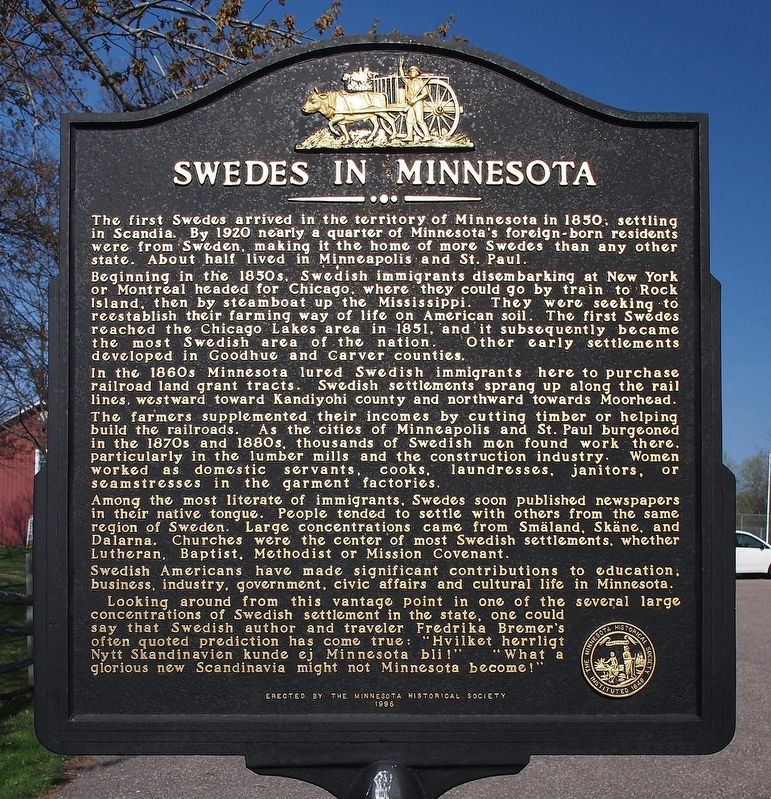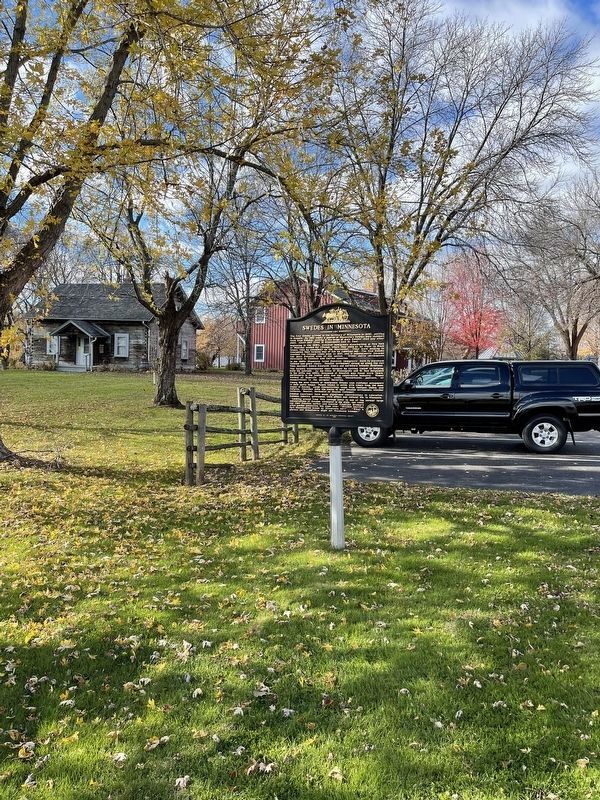Scandia in Washington County, Minnesota — The American Midwest (Upper Plains)
Swedes in Minnesota
Beginning in the 1850s, Swedish immigrants disembarking at New York or Montreal headed for Chicago, where they could go by train to Rock Island, then by steamboat up the Mississippi. They were seeking to reestablish their farming way of life on American soil. The first Swedes reached the Chicago Lakes area in 1851, and it subsequently became the most Swedish area of the nation. Other early settlements developed in Goodhue and Carver counties.
In the 1860s Minnesota lured Swedish immigrants here to purchase railroad land grant tracts. Swedish settlements sprang up along the rail lines, westward toward Kandiyohi county and northward towards Moorhead.
The farmers supplemented their incomes by cutting timber or helping build the railroads. As the cities of Minneapolis and St. Paul burgeoned in the 1870s and 1880s, thousands of Swedish men found work there, particularly in the lumber mills and construction industry. Women worked as domestic servants, cooks, laundresses, janitors, or seamstresses in the garment factories.
Among the most literate of immigrants, Swedes soon published newspapers in their native tongue. People tended to settle with others from the same region of Sweden. Large concentrations came from Smäland, Skäne, and Dalarna. Churches were the center of most Swedish settlements, whether Lutheran, Baptist, Methodist or Mission Covenant.
Swedish Americans have made significant contributions to education, business, industry, government, civic affairs and cultural life in Minnesota.
Looking around from this vantage point in one of the several large concentrations of Swedish settlement in the state, one could say that Swedish author and traveler Fredrika Bremer's often quoted prediction has come true: "Hvilket herrligt Nytt Skandinavien kunde ej Minnesota bli!" "What a glorious new Scandinavia might not Minnesota become!"
Erected 1995 by Minnesota Historical Society.
Topics. This historical marker is listed in these topic lists: Immigration • Settlements & Settlers. A significant historical year for this entry is 1850.
Location. 45° 15.115′ N, 92° 48.429′ W. Marker is in Scandia, Minnesota, in Washington County. Marker is at the intersection of Olinda Trail (County Highway 3) and 209th St N, on the right when traveling south on Olinda Trail. The marker is at the entrance to the parking lot of the Gammelgården Museum. Touch for map. Marker is at or near this postal address: 20880 Olinda Trail N, Scandia MN 55073, United States of America. Touch for directions.
Other nearby markers. At least 8 other markers are within 5 miles of this marker, measured as the crow flies. In Memory of the First Swedish Settlers in Minnesota (approx. 1.4 miles away); Wedge Hill (approx. 2.6 miles away); William O'Brien State Park (approx. 2.8 miles away); Native Cultures and the River (approx. 3 miles away); Lake Alice (approx. 3.1 miles away); White Pines (approx. 3.2 miles away); The Marine Township Hall (approx. 4 miles away); Marine (approx. 4.1 miles away).
Credits. This page was last revised on October 3, 2022. It was originally submitted on June 11, 2018, by McGhiever of Minneapolis, Minnesota. This page has been viewed 905 times since then and 186 times this year. Last updated on October 3, 2022, by Liz Koele of St. Paul, Minnesota. Photos: 1. submitted on June 12, 2018, by McGhiever of Minneapolis, Minnesota. 2. submitted on October 3, 2022, by Liz Koele of St. Paul, Minnesota. • J. Makali Bruton was the editor who published this page.

